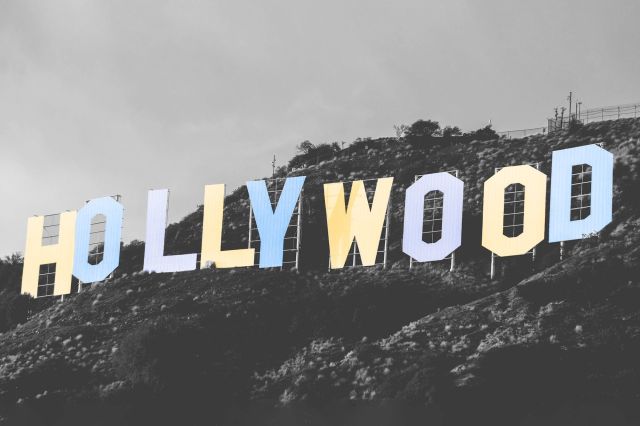
The Sign Was Supposed to Be Temporary
The Hollywood sign wasn’t always the legendary landmark that it is today. When it was first built, it was nothing more than a real estate marketing ploy. In 1923, Harry Chandler, a publisher from the Los Angeles Times, was a major investor in a housing development called Hollywoodland. In an effort to advertise, Chandler spent $21,000 erecting a “Hollywoodland” sign on Mount Lee. The sign was meant to be akin to the billboard, which was a newly popular form of advertising at the time, with one major exception — Chandler employed around 4,000 20-watt light bulbs to illuminate the sign at night. The electric advertisement was considered a marvel, especially since the sign’s lights were timed, with the words “HOLLY,” “WOOD,” and “LAND” lit in consecutive order. In 1949, the L.A. Parks Department made the decision to remove the word “land” so that the sign would better represent the district as a whole.

The Origin Behind the Name Is Murky
While Hollywood is known to be one of the most star-studded locations on the planet, it wasn’t always so. The town for which the Hollywood sign is named has surprisingly humble origins. In 1883, Kansas real estate developer Harvey Henry Wilcox and his wife, Deida, purchased 150 acres of land in California’s Cahuenga Valley. Since he preferred the quiet life, Wilcox intended to create a community of other like-minded people who practiced temperance. He and his wife dubbed their settlement “Hollywood” and the name stuck, although there is much speculation on how the moniker came to be. Some believe the name was inspired by Christmas holly, which grew in abundance in the nearby mountains. Others claim that Deida borrowed the idea from a friend who lived in Holly Canyon. A final postulation claims that Wilcox misheard the words “holly wood” when a Scottish immigrant told him he was “hauling wood.” Since there’s no official evidence behind any of these origin stories, we may never know the truth.

It’s a Magnet for Mischief
The Hollywood sign has been subject to numerous attempts at vandalism over the years. One of the most recent pranks occurred on January 1, 2017, when an unknown man used large tarps to change the spelling from “Hollywood” to “Hollyweed.” But this wasn’t the first time the sign was given a pro-pot makeover. In fact, the stunt was a copycat — the original act was carried out exactly 41 years prior. On January 1, 1976, a small cohort of young college activists changed the sign to “Hollyweed” to celebrate California’s recently relaxed marijuana laws. The same group of people also changed the sign to “Ollywood” in 1987, in support of Lieutenant Colonel Oliver L. North’s testimony during the Iran-Contra scandal. Since then, surveillance cameras have been installed to protect the sign, although these security measures did not protect it in 2017 and the vandal was never caught.
More Interesting Reads

It Has a Resident Ghost
Within 10 years of the Hollywood sign’s construction, it became the site of a tragic death. In the 1930s, Peg Entwistle was an actress who began her career on the Broadway stage and was idolized by a young Bette Davis, who saw Entwistle perform on stage in The Wild Duck. Despite her early success, Entwistle had many setbacks, including a failed marriage to a fellow actor and being cut from her first major picture performance in Thirteen Women. After failing to receive a contract renewal from RKO Pictures, Entwistle used a maintenance ladder to climb to the top of the sign’s “H” before jumping to her death. She was only 24 years old. Since then, sightings of a blonde woman dressed in 1930s garb have been reported by numerous visitors. The ghostly figure of the failed actress is also said to be accompanied by the overwhelming scent of gardenias, which is said to have been the young woman’s preferred fragrance.

It Was Saved by Hugh Hefner Twice
Although the Hollywood sign had been restored during the post-war years, it was in a complete state of deterioration by the late 1970s. An estimated $25,000 was needed by the Hollywood Chamber of Commerce to restore the sign to its former glory or the “eyesore” would be removed. In an effort to save the iconic sign, Hugh Hefner hosted a charity event at the Playboy Mansion and auctioned off the sign’s individual letters to celebrities willing to pay a hefty price tag for a piece of L.A. history. In the end, enough money was raised to rebuild the sign from scratch. Years later, in 2010, the Hollywood sign was once again in danger, as real estate developers were attempting to purchase the surrounding land for building purposes. To thwart the venture, the original Playboy donated $900,000 to a conservation group that was trying to save the land. Thanks to Hefner’s last-ditch effort, the acreage surrounding the Hollywood sign is now protected parkland, filled with walking trails available to the public.











